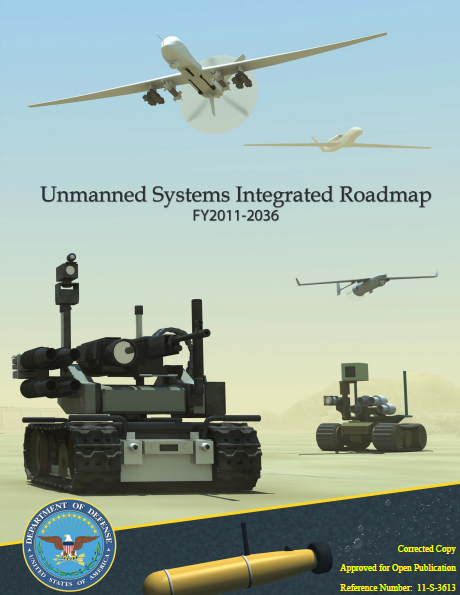Unmanned Systems Integrated Roadmap FY2011-2036
- 108 pages
- October 2011
- 4.62 MB
U.S. and allied combat operations continue to highlight the value of unmanned systems in the modern combat environment. Combatant Commanders (CCDRs) and warfighters value the inherent features of unmanned systems, especially their persistence, versatility, and reduced risk to human life. The U.S. military Services are fielding these systems in rapidly increasing numbers across all domains: air, ground, and maritime. Unmanned systems provide diverse capabilities to the joint commander to conduct operations across the range of military operations: environmental sensing and battlespace awareness; chemical, biological, radiological, and nuclear (CBRN) detection; counter-improvised explosive device (C-IED) capabilities; port security; precision targeting; and precision strike. Furthermore, the capabilities provided by these unmanned systems continue to expand.
The Department of Defense (DoD) has been successful in rapidly developing and fielding unmanned systems. DoD will continue to focus on responding rapidly to CCDR requirements, while ensuring systems are acquired within the framework of DoD’s new wide-ranging Efficiencies Initiatives1. In the fiscal environment facing the Nation, DoD, in concert with industry, must pursue investments and business practices that drive down life-cycle costs for unmanned systems. Affordability will be treated as a key performance parameter (KPP) equal to, if not more important than, schedule and technical performance. DoD will partner with industry to continue to invest in unmanned systems technologies while providing incentives for industry to implement cost-saving measures and rewarding industry members that routinely demonstrate exemplary performance.
…
6 AIRSPACE INTEGRATION (AI)
6.1 Functional Description
Over the past several years, UAS have become a transformational force multiplier for DoD. The numbers and roles of UAS have expanded dramatically to meet mission demands, and operational commanders have come to rely upon robust and persistent ISR support from unmanned platforms executing their core missions against hostile forces. DoD UAS require routine NAS access in order to execute operational, training, and support missions and to support broader military and civil demands. UA will not achieve their full potential military utility to do what manned aircraft do unless they can go where manned aircraft go with the same freedom of navigation, responsiveness, and flexibility. Military aviation is a major contributor to the virtue of maneuver for our forces in warfare.
While the force structure continues to grow, the ability to integrate UAS into the NAS has not kept pace. Current access for UAS is greatly limited primarily due to FAA regulatory compliance issues that govern UAS operations in the NAS. DoD UAS operations conducted outside of restricted, warning, and prohibited areas are authorized only under a (temporary) COA from the FAA. Similar issues need to be resolved for access to international and foreign national airspace.
The DoD UAS Airspace Integration Plan, March, 2011 provides a more comprehensive discussion on the topic of AI. In this plan, DoD provides an incremental approach strategy to provide DoD UAS access to a given operations profile that leads to a full dynamic operations solution. This methodology recognizes that DoD requires access to differing classes and types of airspace as soon as possible and that routine dynamic operations will likely take several years to implement. Figure 12 depicts the six access profiles.
…
6.4.3 Technology
Current UAS are built to different specifications for different purposes; therefore, showing individually that each system is safe for flight in the NAS can be complicated, time consuming, and costly. Routine access cannot happen until DoD and FAA agree to an acceptable level of safety for UAS, and the appropriate standards are developed to meet that threshold. With developed standards, UA will be operationally treated as manned systems, and such treatment will improve interoperability with other systems, cost savings, and development transparency. Until those necessary UAS-specific standards are established, requirements will be dependent on the individual system and intended flight environment (access profiles). Each system’s mission requirements will drive the selection of sense and avoid (SAA) solutions and process for implementation. Ground-based sense and avoid (GBSAA) can provide an initial means to maintain aircraft separation requirements for multiple profiles, while improvements to sensor and automation technology will continue to improve an airborne SAA (ABSAA) solution.
GBSAA efforts are focused on developing methods to provide aircraft separation within a prescribed volume of airspace using a ground-based system that includes sensors, displays, communications, and software. GBSAA solutions will incrementally relieve restrictions on existing COAs and facilitate UAS training and operations in the NAS. This effort is establishing requirements, gathering data, performing modeling and simulation, testing and verifying collected data, and obtaining airworthiness approvals, as appropriate. GBSAA can particularly benefit smaller UAS where other SAA solutions are cost prohibitive.
ABSAA efforts are focused on developing onboard capability to perform both self-separation and collision avoidance that ensure an appropriate level of safety. Current programs have phased validation schedules for due regard, en-route/Class A, and divert/ Class E/G operations as technology innovation and integration allow. GBSAA and ABSAA may be applied as a single or combined solution to some access profiles to maximize safety and/or reduce operational costs.

